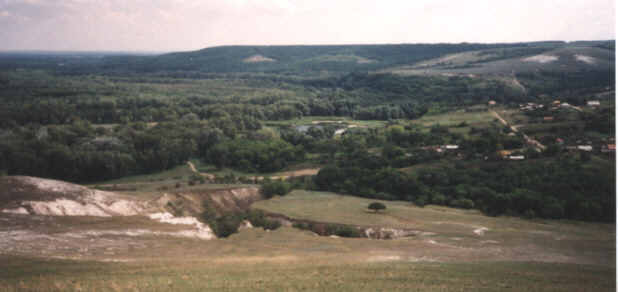
GEOGRAPHY
The area around the Khopyor belongs to the steppe-belt.
It was only as late as the 18th century that this "wild field"
was farmed at all. The fertile black earth, the large number of rivers
and streams, and a long period of growth (200 days per annum) create ideal
conditions for agriculture.
|

The Khopyor valley near Lukovskaya
|
Still, crop failure is recurrent. Frequent droughts and
strong winds are climatic risk, which the sparsely wooded landscape can hardly
defend itself against.
The continental climate which dominates the steppe brings
drastic temperature changes between summer and winter. In Uryupinsk, the different
between the summer and winter temperature comes close to 80 degrees. The icey
winter storms are especially feared.
The broad landscape of the steppe is also formed by the
large rivers (the Khopyor, the Medveditsa and the Don) and their tributaries.
Cutting into geological layers of various ages, they partially left terraced
banks. Thus, the landscapes on the rivers are varied and pleasant, in contrast
to the monotony of the steppe. One can gain a good impression of the geological-historical
"achievements" of the Khopyor river if one visits the stanitsa Lukovskaya.
From the slopes around the stanitsa, one has a good vantage of the Khopyor valley
which spreads wavily from the river-bed.
In geological terms, the Khopyor basin is very old, even
older than the basins of the Volga or the Dnepr. The present valley was dug
by the river during the last ice age, when glacial masses penetrated this region.
The right bank of the river continues into the Kalatsh heights, while the land
on the left bank slopes back down into flatlands.
The Kalatsh heights are especially vulnerable to erosion
through wind and water. Countless gullies and ravines form the steppe and the
right bank with its chalky/sandy slopes; there are between 0.8 and 2km of ravines
to 1 square kilometer here. Some of these are environmentally protected, as
are the oaks in the national reserve of "Shemayakinskaya dacha".
Marion Krause
Last changed: 18.5.2000

